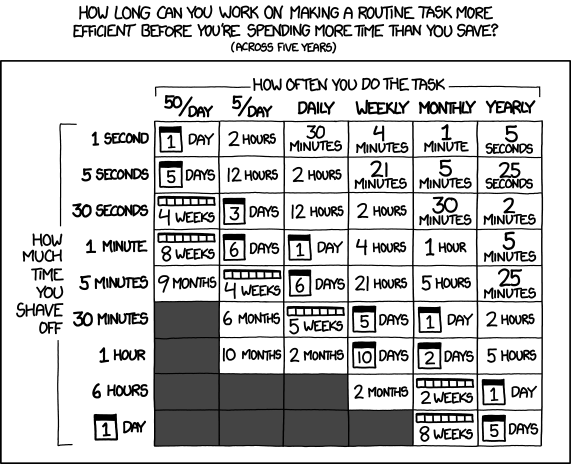Automation is a big part of IT, but not all automation brings value. Automation takes time and effort, upfront, and any benefits come later.
Think of the IT projects you were involved in, most of those aimed at providing a measurable benefit somewhere.
This diagram (from xkcd, a series of webcomics) illustrates when automating repetitive tasks, or even just parts of them, brings benefit. In other words, is there a business case for such an intervention?

The objective of this diagram is to show how much time you can invest in automating tasks. You can think of tasks such as:
- converting a spreadsheet to another data format
- scheduling an appointment
- looking up some research
- running a test
- installing a new version of a piece of software
- saving a piece of evidence for an audit
- setting up an auto reply rule in a mailbox
Such manual tasks can be shortened or eliminated with a bit more automation. The top row of the diagram indicates how often that task is done. The left column shows how much time the automation would save, per individual execution of the task.
Each cell in the table then shows the amount of effort that you can spend on that automation and still have a net positive outcome over five years. The table contains a number of black (empty) cells. My understanding is that these are ‘impossible’ situations. For example, you cannot execute a one-hour task fifty times a day, according to this table. This is only true, in my opinion, if you assume a single person is doing that task. If a whole team can benefit from the automation, there would be useful numbers in those cells as well.
Each cell shows what investment would have a five-year break-even point, as it is called, that is: if you spend this amount of time on it, the break-even point will be five years. If only half the investment is necessary, the break-even point will be two-and-a-half years. If only a tenth of the investment is necessary, the break-even point will be six months.
For example, if I can reduce the time it takes to do a daily task by one minute, two hours of investment in that will be paid back in about six months.
Of course this is a simple way of looking at those business cases. This does not take into account other costs or benefits. A couple of examples of that:
- computer usage is not included as a cost
- maintenance over the five year period is not included
- the use case you are automating could change drastically in five years, making your automation obsolete
- automation often leads to more consistent quality, especially as you use it more often, a great example of that is in automated testing
All of this uncertainty favors focusing on automating tasks where the benefit substantially outweighs the cost. Don’t get carried away by automation with small returns.